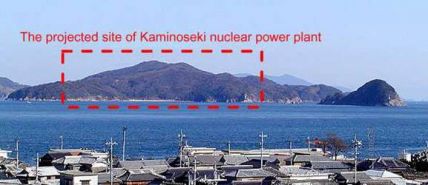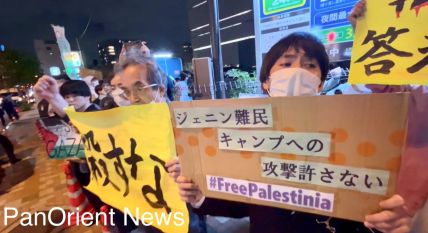|
|
Environment
Five Japanese in Hunger Strike Against Kaminoseki Nuclear Power Plant
Saturday, January 29, 2011

Tokyo - (PanOrient News) Five Japanese young people are in the ninth day of a hunger strike outside the Prefectural Government offices in Yamaguchi City to protest land fill and sea reclamation work in preparation for construction of a nuclear power plant on the coast of the environmentally sensitive Seto Inland Sea.
A Press Release by Citizens' Nuclear Information Center said the hunger strikers (2 aged 19, 3 aged 20) plan to continue their hunger strike at least until the tenth day (Sunday 30th), when they will conduct a one-hour sit-in from 12 noon outside the Prefectural Government offices. The sit-in is expected to be be joined by Diet Members from the Social Democratic Party and other supporters. Beyond Sunday, their plans will depend on their physical condition, according to the release.
The Seto Inland Sea is sometimes referred to as Japan’s Galapagos because of its rich environmental diversity.
Chugoku Electric Power Company operates two nuclear power plants and is currently constructing a third on the Japan Sea coast in Matsue City, the capital of Shimane Prefecture, local groups said. On the other side of western Honshu (Japan's main island), it plans to build two nuclear power plants on the Seto Inland Sea coast in Kaminoseki Town, Yamaguchi Prefecture.
Kaminoseki Town comprises a peninsula and several islands. It has a population of 3,600 people. The proposed construction site is on Nagashima Island which is connected by a bridge to the mainland. Iwaishima Island, which has a population of 500 people "who are almost all opposed to the nuclear power plant," is just 3.5 km across the sea from the construction site.
The surface area of the proposed site is about 330,000 m2, about 40% (140,000 m2) of which will be reclaimed from the sea. Cooling water will be taken from the north side and released on the south side of the island. Tunnels will connect the inlet and outlet to the turbine buildings, which will be located inland of the reactors. The reactor building of the second plant will be located on reclaimed land.
Preparation of the site is scheduled to take five years and reclamation work three years. The first plant is scheduled to commence operation in 2015, while the second plant is scheduled to commence operation in 2020.
The only settlement on Iwaishima Island directly faces the construction site across the narrow channel. The islanders' livelihoods are based on fishing and small-scale farming.
When the plan for a nuclear power plant first emerged in 1982 the overwhelming majority of the island's population were opposed to it and in 1983 the then Iwaishima Fishing Cooperative passed a resolution opposing the plan. To this day, 90% of the island's population opposes the plan, local NGO said. For the last 27 years they have held a demonstration every Monday under the slogan "We will not sell the sea for a nuclear power plant." The demonstration has now been held over 1050 times and has become part of the local culture.
Activists claim that the Japanese government "accepted Chugoku Electric's woefully inadequate environmental assessment." They said The Ecological Society of Japan strongly criticized Chugoku Electric's environmental assessment saying, "The survey and analysis of each species is inadequate." "It fails to grasp the development, breeding environment and food chain for the species." "No assessment deserving the name of an ecosystem assessment has been carried out."
Below is a statement by the Five Hunger Strikers:
Five Hunger Strikers’ Appeal Against Construction of the Kaminoseki Nuclear Power Plant
We began a hunger strike on the afternoon of January 21 to call for the temporary suspension of land fill and sea reclamation work at the proposed site of a nuclear power plant at Tanoura, Kaminoseki Town, Yamaguchi Prefecture and for reconsideration of the approval for this work.
We decided to take this action because we do not want the radioactive waste that will arise and the radioactivity that will accumulate in the sea and the atmosphere as a consequence of constructing and operating this nuclear power plant to be left to our own and our children’s generations.
Radioactive waste continues to release radioactivity for thousands of years, but no means of disposing of it has been established. Furthermore, although nuclear power plants can only be operated for about 40 years and the buildings themselves become radioactive in the process, no safe method of decommissioning them after they are shut down has been found.
Nevertheless, they are going ahead with a plan to construct a new nuclear power plant at Kaminoseki Town in Yamaguchi Prefecture. To construct a new nuclear power plant when there is neither a method of disposing of the radioactive waste that will be produced in the process of operating the plant, nor a method of decommissioning the plant after it is shut down is to bequeath the problems to generations of young people to come.
None of us are residents of Kaminoseki Town, but the problems of this nuclear power plant are by no means problems just for Kaminoseki. They are problems for the whole country.
We want to inform as many people as possible about this issue and to communicate the reality of what is now happening at Kaminoseki and our feelings about the matter to the Governor of Yamaguchi Prefecture, who approved landfill and sea reclamation work at Tanoura, Kaminoseki Town, Yamaguchi Prefecture.
This hunger strike will only become meaningful if it captures the attention of people throughout Japan. We need your strength. If you agree with the sentiments expressed in our appeal, please forward it to as many people as possible.
And if you have some time, please phone or fax the Yamaguchi Prefectural Government Office and Chugoku Electric Power Company, which is proceeding with its plan to build a nuclear power plant at this site. Please ask them about our hunger strike.
Of course, we welcome anyone, regardless of age or gender, who wishes to join our hunger strike.
We repeat, we need everyone’s strength for this action. We are laying our bodies on the line in order to communicate our feelings. We ask for your support.
Naoya Okamoto (Kin-chan, age 20)
Gen Matsumura (Gen-chan, age 19)
kanta Yonehara (Kan-chan, age 20)
Ereki Kobayashi (Gin-chan, age 20)
Rei Funamizu (Tama-chan, age 20)
Photo: Courtesy of The People of Iwaishima's Association Against the Kaminoseki Nuclear Station
PanOrient News
© PanOrient News All Rights Reserved.
|
|

